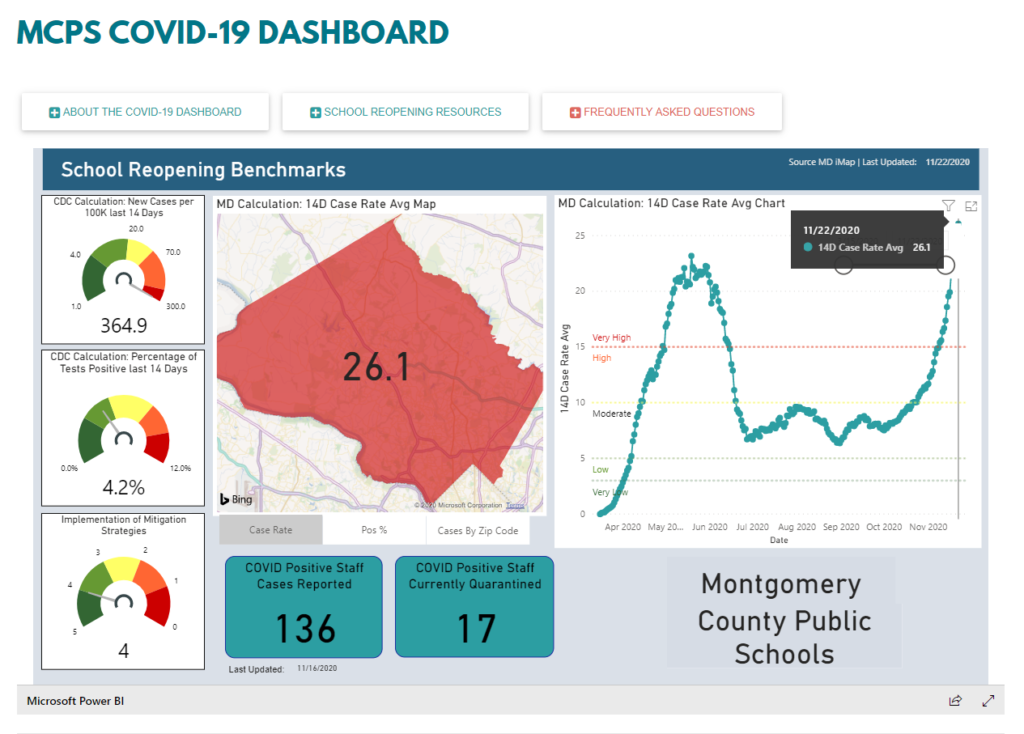By Adam Pagnucco.
One week ago, I asked “Will MCPS Reopen?” At that time, a number of factors poured cold water on MCPS’s plan to resume in-person instruction in January, including rising COVID case rates, potential costs with few options to pay for them and the experience of other districts in reopening and then promptly shutting down again. Events since then have made it even more unlikely that MCPS will reopen on schedule.
Consider the following.
1. In my post a week ago, I noted that schools in Allegany, Dorchester, Harford and Somerset counties all reopened and then closed again due to COVID spikes. Since then, Baltimore City, Baltimore County, Carroll County and Fairfax County have paused, suspended or delayed reopening and New York City has shut down its schools. Most ominously, Howard County’s school board voted against a reopening plan submitted by their superintendent and opted to keep schools virtual through at least April. This no doubt caught the attention of MCPS management. Having a school board publicly reject a crucial policy decision is a nightmare scenario for any superintendent and one that MCPS Superintendent Jack Smith will be keen to avoid.
2. County health officer Travis Gayles is urging private schools to use virtual learning only. Gayles tried to shut down private schools last summer but was stopped by the state. Nevertheless, he continues to believe that in-person learning is unsafe in the context of rising case rates, a message he has no doubt shared with MCPS.
3. Governor Larry Hogan imposed a set of new restrictions on bars, restaurants, retailers, gyms and religious institutions last week as COVID cases surged across the state. County Executive Marc Elrich plans to impose more restrictions too. The Smithsonian has closed the National Zoo and all of its museums in response to the surge. In his bluntest remarks to date, Hogan told Marylanders, “Just wear the damn mask.”
4. Looming over all of this is an unprecedented skyrocketing of COVID case rates. MCPS’s COVID dashboard uses a 14-day average case rate. A week ago, the rate was 19.5 cases per 100,000 residents. As of yesterday, the rate was 26.1, far above the level of 15.0 at which any students would be considered for in-person learning. The county’s 7-day average case rate jumped from 22.4 to 29.7 over the same period. Both the 7-day and 14-day averages are above previous peaks seen in May, when schools were shut down and economic restrictions were more severe.

MCPS’s COVID dashboard as it appeared yesterday.
5. Yesterday, the Post summarized the consensus of health officials in the region this way: “Public health experts and hospital administrators say the abrupt rise in new cases is unlikely to abate in the next few weeks and could foreshadow a more difficult December, followed by an even rougher January and a darker February.” In other words, it’s going to get worse before it gets better.
Despite all of this, MCPS is proceeding with a survey of parents asking whether they prefer hybrid (in-person and virtual) or virtual-only learning in the second semester. The survey says in bold that the system “will begin a phased-in return to in-person instruction on January 12, 2021.” Notice use of the word “will.” As of a week ago, 56% of responding parents preferred the hybrid option.
If schools were to reopen today, no students would be eligible for in-person learning according to MCPS’s own health metrics and the public health community believes that case rates have not yet peaked. However, MCPS is still telling parents that schools “will” resume in-person learning in January. At this point, MCPS management is on a collision course with some parents who want in-person instruction but likely won’t get it any time soon as well as with its own employees, many of whom fear for their health if called back to MCPS buildings.
It’s a very tough situation. And the longer MCPS management waits to adjust its course, the tougher it’s going to get.
Update: MCPS Chief of Engagement, Innovation and Operations Derek Turner points out that MCPS’s Family Guide to Help Determine Learning Preferences states the following:
Montgomery County Public Schools (MCPS) will offer both virtual and in-person learning experiences as health metrics allow. MCPS will begin a phased-in return to in-person instruction beginning January 12, 2021, with a focus on specific special education programs and certain Career and Technology Education (CTE) programs. If health metrics continue to be met, larger groups of students will begin phasing in on February 1, 2021.
Turner said, “By not including this important context, and in fact emphasizing the word ‘will’, readers may believe that MCPS is pushing forward with no concern for the health and safety of students and staff, which is far from the truth. I am asking that you update your piece to reflect the important context regarding health metric being met before a return to in-person can occur.”


